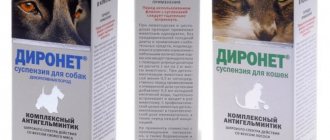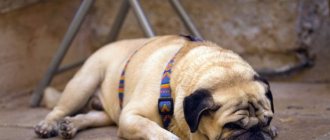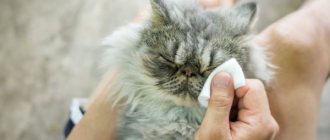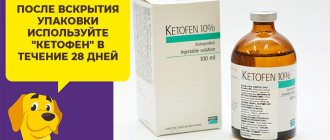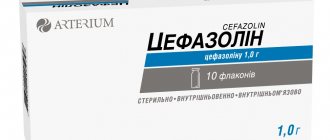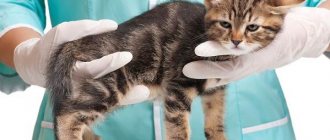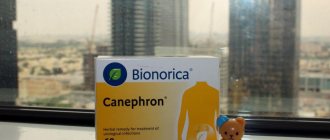It is difficult to find a person whose pet has never become infected with fleas. Even in modern times, ectoparasites pose a serious problem for every cat or dog owner. Fortunately, a lot of veterinary products are produced to combat blood-sucking insects. Insecticidal drops are very popular today; applying them to the withers of an animal causes the death of pests. However, this efficiency indicator indicates the high toxicity of the drug. Many owners of mustachioed pets are puzzled by the question of what to do if a cat is poisoned by flea drops.
Composition and release form
Dironet differs from other anthelmintic drugs complex formula. The drug contains active ingredients that have been used in veterinary practice for a long time. These are pyrantel, praziquantel and ivermectin.
Pyrantel is able to remain in the animal’s body for a long time, as a result of which there is an active effect on parasitic worms from the moment the drug is taken. As a result of exposure to this substance, the muscles of round and tapeworms are paralyzed, which are deprived of the ability to feed and move.
Praziquantel disrupts the transmission of nerve impulses and blocks the transport of glucose in the body of the worm. The product is very quickly eliminated from the cat’s body through urine.
Ivermectin is active against exoparasites – fleas and ticks. The active effect of the drug occurs within four hours after its use. Dironet is produced in several convenient forms:
- Dironet spot is a drop for applying to the withers of an animal;
- suspension;
- pills.
Dironet spot drops on the withers are used only to kill ticks and fleas; there is no guarantee of impact on parasitic worms. The medicine is packaged in convenient plastic droppers. The drops are a yellow liquid with a specific odor.
The suspension has a creamy texture and a fishy odor, which allows to be used even for very suspicious cats.
A convenient syringe dispenser allows you to accurately measure the required amount of medicine.
The Right Action
If a cat is poisoned by flea drops, it is treated in almost the same way as a human. The best decision is to seek help from a veterinarian. If this is not possible, proceed to independent therapy.
- Rice water helps against poisoning. Normalizes the functioning of the digestive tract, eliminates diarrhea. Add 2 tbsp to 500 ml of water. spoons of rice, cook for 40 minutes. The broth should be cooled and given to a cat or kitten.
- Poisoning of a kitten with flea drops is treated with Smecta. Dilute half the sachet in 20 ml of water and give it to your pet from a pipette or syringe.
- Enterosgel paste and an activated carbon tablet are used as an adsorbent to remove toxins from the body. The medicine is pre-dissolved in water.
- If the poisoning is severe, you should give an enema with a weak solution of potassium permanganate.
- For pain relief, you can give 0.5 tablets of analgin, baralgin, no-shpa.
How does Dironet work?
The drug destroys adults, larvae and eggs of helminths, roundworms and nematodes; subcutaneous, nasopharyngeal and cutaneous parasites, lice and fleas, ticks.
The active substance affects the nervous system of the parasite and causes its death.
After administration, the medicine is quickly absorbed and distributed in the tissues and organs of the animal. The drug continues for 10-14 days. Residues of the drug are excreted in the urine and partially in bile. During lactation, Dironet penetrates into milk.
After using the drug, the active substances spread in the upper layers of the skin and accumulate in the hair follicles and sebaceous glands. Part of the medicine enters the bloodstream and internal organs of the animal.
Dironet spot, in a short time, rids the cat of helminths and external parasites. The use of the product is suitable if it is not possible to give the animal a tablet or suspension.
Safety precautions for application
The manufacturer's recommendations indicate that the composition should be applied to the area between the shoulder blades along the spine. The cat will not be able to turn its head so as to reach the withers area.
Unfortunately, correct application does not provide a 100% guarantee of protection against droplets getting into the animal. To prevent flea treatment from causing poisoning, you should adhere to the following rules:
- do not apply drops in a long line (an area of 2 cm is sufficient);
- try to distribute the medicine closer to the hair roots;
- If there are several cats in the house, isolate them from each other during treatment.
You can try to protect especially resourceful cats by attaching a collar to the neck. It will fix the head and prevent it from reaching the areas treated with insecticide. The time for complete absorption of the drug is about 2 hours (manufacturers indicate the exact period in the annotation). After this, the remaining drops become completely safe.
Contraindications
To avoid negative consequences, the use of the drug is prohibited in the following cases:
- for the treatment of sick and weakened animals;
- kittens under two months old;
- pregnant females;
- when used in combination with other antiparasitic agents.
Dironet has no side effects. An exception may be cases of individual intolerance to individual components of the drug.
Very rarely, side effects may manifest themselves in the form of increased salivation, vomiting, trembling of the limbs or irritation of the skin. In this case, stop using Dironet, and the remaining product should be washed off using detergent.
Possible side effects and contraindications
When using all forms of the drug Dironet in strict accordance with the instructions, the occurrence of side effects and complications is unlikely. However, in all cases, the contraindication is the animal’s excessive sensitivity to the components of the drug, as well as the period of gestation, lactation (except for the Dironet Junior suspension) and the age of the kitten up to 3 weeks.
If an allergic reaction occurs while using the drug, you should stop taking the medication and give the animal antihistamine therapy. Spot-on drops should be removed from the skin as quickly as possible using soap and water. Allergies can manifest as watery eyes, excessive saliva production, vomiting, redness and irritation of the skin.
An overdose may result in symptoms such as lethargy, passivity, lack of appetite, drooling, diarrhea or constipation. Such cases require the intervention of a veterinarian.
Instructions for use and dosage
Dironet spot drops are applied to clean, undamaged skin of the cat in the withers area, after spreading the fur. The drug should be applied to places that are inaccessible for licking. After applying the product, it is not recommended to wash the animal for 4-5 days.
The dosage of the drug is calculated based on the weight of the animal. For kittens it is 0.1 ml per kilogram of animal body weight.
To kill fleas and lice eaters, the cat is treated once. For preventive purposes, the product can be used once a month during the period of parasite activity.
To get rid of ear mites, the product is used once. Repeated treatment, if necessary, is possible after a month. Before use, you should clean the ear from any dirt. If an animal is diagnosed with otitis, then Dironet is used in conjunction with antimicrobial and anti-inflammatory drugs.
For demodicosis, sarcoptic mange, and notoedrosis, the drug is used two to four times with a break of 10 days. After using the drug, it is necessary to conduct a double laboratory acarological study to confirm the positive result of treatment.
To get rid of helminths, Dironet is used once. Prevention of intestinal invasions is carried out once every three months.
tablets are taken orally. To do this, carefully grind the product and mix it into your cat’s food or treat. You can also give the drug forcibly by placing it on the root of the tongue.
One Dironet tablet is designed for 10 kilograms of animal weight. Tablets are recommended to be used for prevention once every three months, for treatment - once.
You can purchase the drug at a veterinary pharmacy. The average price for a package of the drug is from 250 rubles.
Indications for use and principle of action
Most often, domestic cats suffer from the following helminthic diseases: nematodes (roundworms) and cestodiases (tapeworms). It is these types of worms that Dironet fights. An animal can become infected with nematode disease by eating contaminated meat or ingesting street dirt and dust containing parasite eggs. The carriers of tapeworms are lice and fleas.
Cats can get cestodosis by ingesting fleas and lice.
The drug is also effective in preventing dirofilariasis . This is a dangerous disease caused by parasitism of nematodes of the species Dirofilaria repens (live in the subcutaneous fatty tissue and eyes) and Dirofilaria immitis (in the heart and lungs). Dirofilariasis is transmitted through the bites of intermediate hosts—mosquitoes. It should be noted that Dironet destroys only the larvae of these parasites and is useless against adults.
Pills
The tablets are flat in shape and yellow to grayish in color. On one side there is a line dividing them into two parts, on the other there is the manufacturer’s logo. The content of active ingredients is: pyrantel pamoate - 150 mg, praziquantel - 50 mg, ivermectin - 60 mg, in addition, lactose and potato starch are added to the drug.
The price of Dironet tablets for cats varies from 200 to 250 rubles per package
The combination of three active components at once has a depressing effect on all phases of the life cycle of nematodes and cestodes (Toxascaris leonina, Trichuris vulpis, Toxocara cati and many others), as well as microfilariae.
Pyrantel pamoate leads to neuromuscular blockade, paralysis and death of roundworms of both sexes and any stage of sexual maturity.
Praziquantel in small doses causes muscle spasms and immobilization, leading over time to the death of tapeworms. A high concentration of this substance leads to the destruction of the outer cover of the worms, resulting in death very quickly.
Ivermectin affects the neurons of roundworms and external parasites (fleas, ticks), disrupting signal transmission in them and ultimately leading to loss of motor function and death.
This form of the drug is indicated for pets to get rid of:
- nematodes of the gastrointestinal tract;
- cestodiasis;
- dirofilariasis.
Drops spot-on
This type of drug looks like a yellow liquid, poured into plastic tubes of various capacities (from 0.5 to 2 ml). 1 ml of liquid contains 85 mg of praziquantel and 5 mg of ivermectin, as well as dimethyl sulfoxide and benzyl alcohol.
The cost of Dironet spot-on drops on the withers is about 300 rubles
The product is characterized by multifunctionality, destroying not only worms, but also fleas, lice, lice, scabies mites. After treating the animal's skin with this product, its components are concentrated in the epidermis, hair follicles and sebaceous glands of the cat, then partially absorbed and distributed in the blood throughout the body, contributing to the death of intestinal worms. In this case, the product accumulates in the outer integument of the animal and not only destroys ectoparasites, but also prevents re-infection with them for some period.
Dironet spot-on is prescribed to pets older than 2 months for the treatment and prevention of the following diseases:
- intestinal nematodes;
- cestodiasis;
- entomoses (external parasites);
- otodectosis (ear mites);
- sarcoptic mange and notoedrosis (itching mites);
- demodicosis (subcutaneous mites).
Dironet spot-on drops for kittens are also sold - the product is simply packaged in smaller pipettes (about.5 ml in one pipette, while a pipette for an adult cat contains 1 ml of the drug)
I would like to share my friend’s experience of using Dironet spot-on. She lives in a country house and has three cats. Two out of three pets constantly walk outside the house, so a friend regularly treats all animals for fleas and worms. Previously, she used flea collars and the cheapest deworming medications, but on the advice of a pet store salesperson, she purchased Dironet drops to try. It was a bit of a challenge to properly apply the product to three reluctant cats, but she managed. The fur was dirty for some time and the cats tried to lick the product from their withers, but they could hardly reach it. The fleas soon disappeared, and as for the worms, it was not known whether they existed at all. But they say that if cats walk outside, then some parasites are definitely present in their bodies. Since the animals are cheerful and healthy, they do not show symptoms of worms, such as problems with the eyes, hair, digestive disorders or poor appetite, the friend believes that Dironet spot-on helps against worms too. Now she treats all three pets with these drops once a quarter. Inexpensive and effective.
Suspension
Dironet suspension for internal use looks like a viscous yellow substance, poured into polymer packaging: volumes of 1, 5, 10, 20 and 60 ml. There may be separation of the liquid into layers, which should disappear with vigorous shaking.
The cost of Dironet suspension for cats is approximately 230 rubles
1 ml of suspension contains 15 mg of pyrantel pamoate, 5 mg of praziquantel and 6 mcg of ivermectin, as well as nipagin, nipazole, Tween-80, lactose, distilled water. The principle of action and purpose of the suspension and tablets are the same. Tablets are richer in active ingredients, which is why they are more often chosen by dog owners, and the suspension by cats. In addition, some animals are easier to give a tablet than a liquid, and vice versa.
Suspension for kittens
LLC "Agrovetzashchita" has developed a special medicine for small pets - Dironet Junior This is a yellow liquid, sometimes breaking up into separate layers during storage, but becoming homogeneous when shaken.
The cost of the Dironet Junior suspension is approximately 230 rubles
The suspension for young individuals contains only pyrantel pamoate (15 mg) and sodium ribonucleate (0.5 mg), as well as minor ingredients: nipagin, nipazole, sugar, Tween-80, water. The first active component destroys nematodes, and the second stimulates the formation of lymphocytes, increasing immunity, and helps intestinal cells damaged by worms recover.
The drug is indicated for kittens over 21 days old to prevent and cure the following diseases:
- toxocariasis;
- toxascariasis;
- uncinariasis;
- hookworm;
- trichocephalosis.
Reviews
The cat was given to me by friends who were moving to another city. There were no problems with the animal. Only I missed that the animal needs to be dewormed periodically, so I went to the veterinary clinic. After examination, the cat was found to have intestinal parasites. The vet recommended using Dironet. The drops turned out to be very convenient to use, in addition, they relieved the animal of fleas. The very next day the remnants of worms began to come out. After use, we were tested again and no more parasites were found. Currently I use the drug for preventive purposes.
Tatiana
On the recommendation of a veterinarian, I use Dironet spot drops to treat two cats. Animals tolerate the treatment well, no side effects of the drug are observed. With systematic use of the product, cats have never become infected.
Galina
Recently I noticed that the cat began to lose weight and eat poorly.
Worms were found in the feces. The veterinary pharmacy recommended using Dironet. I used the tablets along with food. After a few days, the animal’s health returned to normal. Irina
How does poisoning manifest in a cat?
It is very important to notice in time that the cat has licked the flea drops.
The following symptoms should alert the owner:
- the cat refuses its usual and favorite food;
- diarrhea begins;
- the cat constantly drinks water;
- the animal loses orientation in space, cannot group itself for a jump, it staggers, skids;
- salivation increases;
- The animal's pupils dilate.
Symptoms can be expressed in different ways, it all depends on how much insecticide enters the body. Of course, you don’t have to be afraid of a fatal outcome - in the worst case, the fluffy will lick only a few drops.
It is worth distinguishing between the symptoms of intoxication and allergies. Individual intolerance may occur when using a new drug. It is expressed in lacrimation, redness of the skin, and the appearance of bald patches at the site of application.
To reduce the likelihood of poisoning and allergies, you should give preference to medications from trusted companies.
Is it possible to give cats Dironet?
If the medicine is supplied to veterinary pharmacies, then, of course, it must be approved for use, having previously received all the relevant certificates. However, in practice, many formulations are not suitable for specific animals, so some owners additionally turn to veterinarians on a case-by-case basis.
We also recommend reading about the use of the anthelmintic drug Milprazone.
The medicinal antiparasitic drug "Dironet" has many positive reviews, both from doctors and from animal owners themselves, which means that if the dosage and rules for using the composition are followed, there should be no adverse reactions and it can be given to cats.
What to do if your cat is poisoned?
When a cat is poisoned by flea drops, the recovery period depends on the measures taken by the owner, who must know what to do first to stop the manifestations of intoxication and how to provide basic treatment. Particular attention is paid to the nutrition of the affected cat.
First aid for an animal
Treatment of a cat poisoned by flea drops begins with sorbent agents. Medicines in this group relieve attacks of nausea, act like a sponge, absorbing insecticides and preventing them from penetrating the blood.
For representatives of the cat family, the medications listed in the table are suitable:
| Name of medicine | Dosage |
| Activated carbon | 1 tablet per 1 kg of cat weight, 3-4 times a day |
| Polysorb | 0.1-0.2 g per 1 kg of body weight |
| Filtrum | 7 g of the drug is diluted in 50 ml of water and given to the pet 2-4 ml per 1 kg of body weight |
| Enterosgel | 1 cm of paste, squeezed onto a spoon |
| Smecta | 1-2 ml of solution per 1 kg of animal weight, 2-5 times a day |
They bind and remove toxins, as a result of which digestion is normalized, intestinal motility and kidney function are improved.
The second most common symptom that occurs if a cat licks flea drops is diarrhea. Smecta will handle its elimination. Additionally, rice or chamomile infusion is given. It is prepared from 1 tbsp. cereals (or dried vegetable collection) and 1.5 tbsp. water. The ingredients are boiled, filtered, cooled and given to your pet to drink.
Treatment of a poisoned cat
Poisoning with flea drops, even with proper and timely treatment, does not go away in a couple of hours. To help your pet, you will have to organize a full-fledged therapeutic course. It is convenient to use a syringe without a needle to administer medications. A healing solution is injected into it, the required amount of which is determined using a measuring scale on the body of the device.
Introduction technique:
- hold the cat motionless;
- throw back the animal's head;
- press your fingers on both sides into the area between the lower and upper teeth;
- pour the drug solution into the cheek in small portions.
The medicine Drotaverine (NoShpa) or Baralgin will help against flea poisoning accompanied by pain. Taking these medications does not have the best effect on the animal’s digestion. After the therapy, the intestinal microflora will have to be restored. The drug Vetelact will cope well with the task.
Vetelakt
If intoxication caused by poisoning with flea drops does not go away and the cat spits out all the medicine, injections into the thigh area are allowed. However, the veterinarian must give the injections.
Feeding a cat after poisoning
Properly organized nutrition is one of the main conditions that determine how quickly a cat will recover. If a cat is poisoned with flea drops, it is deprived of food for a day. The digestive tract irritated by insecticides must be protected from stress. It is advisable to clean the full stomach by inducing vomiting in the cat. If necessary, do an enema.
Strong thirst after intoxication is a good sign. The more the animal drinks, the sooner the recovery will occur. For weakened cats that refuse fluids, water is forcibly infused at a rate of 5 ml at a time.
When the main symptoms of poisoning pass, the pet is transferred to a diet menu of cereals, chicken broth and fermented milk products. Meat and dry food are banned for a week.
Features of kitten treatment
It becomes more difficult when a kitten is poisoned by flea drops. It receives the same concentration of insecticides, and its body weight is several times less than that of an adult animal. In order not to risk your pet’s health, at the slightest sign of discomfort, it is better to contact a veterinarian.
In general, the technology for treating kittens is the same as for adults. It is supplemented with the following groups of drugs:
- decoctions that give a diuretic effect (lingonberries, bearberry, tansy, St. John's wort are suitable);
- veterinary medications that support the functioning of the liver (Hepatovet, Hepatolux, Gepasafe, Corsil);
- saline and glucose to support animals with severe dehydration.
The standard course of treatment is 30 days, but if necessary, it is adjusted by the veterinarian based on the general condition of the patient and the emerging dynamics.
